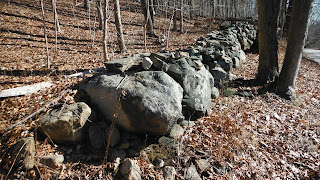That's the beautiful thing about sharing an interest in this Stone Features business with other people: you sometimes see something you've missed when you see something someone photographed somewhere where someone has seen something somewhere and it triggers something somewhere in your memory causing you go back somewhere and take a second look, either in person or in a photograph, and you see you missed something, sometimes in more than one somewhere, but you probably won't miss it again because you start looking for it and you've learned something.
Here's a certain something somewhere I saw just last night, in this photo posted up at Rock Piles :
Here's a certain something somewhere I saw just last night, in this photo posted up at Rock Piles :
(Photo credit: Sydney Blackwell)
The white quartz cobble on that big boulder certainly does capture a person's attention. And, unless you are a very stubborn "old school" archaeologist or State Historic Preservation Officer, you should be able to see that here is a Stone Feature of the Indigenous Cultural Landscape that is sometimes known as a Serpent "Wall" that in truth is probably better described as a petroform or a geoglyph, that represents a well known mythical or legendary figure in this half of the world that I think of as "A Great Serpent," just to keep things simple since the creature has so many names in so many Indigenous languages.
So as often happens, I start thinking about another Serpent somewhere, and accidentally stumble on a photo you could say is literally "closer to home," since it is a Serpent not far from the house I live in, on the way up from my road that wears the name of the Indian Trail that leads to another Indian Trail that now wears the very imaginative name "Route 6." There's a whole pile of names applied to this road, but if you go back far enough, you'll find that it was an ancient Indian Trail too.
I designate this Serpent as Buford's Serpent because it's at the entrance of a friend's driveway and since he's the same age as my brother Steven, who gave him the name "Buford" because his name is also Steven - and people just like to say "Buford" as well. The Serpent is part of the old stone border of the trail, one segment of two remnants that I conjecture weren't removed and re-used for something else since they were already being re-used as a "farm fence."
I had a little "I'll be durned!" moment as I looked again at the stones on top of "head stone" and saw a little bit of white quartz peeking out at me:
Coincidence? Maybe but maybe not.
I looked into another folder of photos, another spot that the stone wall mythology insists is another "farmer's gate" but in reality is probably another Serpent Gateway:
(See: http://wakinguponturtleisland.blogspot.com/2015/01/another-possible-ophiomorphic-petroform.html)
Closer, three light colored quartz (or quartzite?) stones and we now have a conspiracy:
More? Well, so far I can easily find these:
(Best I could do here. I wasn't looking for it and between the serpent head and that other stone on the other side of the gateway, I was focused elsewhere:)
(Also at: http://wakinguponturtleisland.blogspot.com/2015/01/another-possible-ophiomorphic-petroform.html)
White quartz vein already there on running through a certain strikingly Serpent-like Head Stone at a gateway at the end of a long row of carefully stacked stones, you might not need a white stone quartz stone (maybe the jewel or the "blazing diamond" called Ulûñsû'tî or "Transparent" now that I think about it - and Mooney and Uktena and all the other similar stories) sitting on or just touching the headstone - but what's that: a fallen light colored quartz or quartzite (or quartzish?) stone?
Negative Evidence?
Maybe, maybe not...
I guess I'll be looking for more repetition of this possible pattern, in photos and in person from now on; what you find all depends on what you are looking for...










No comments:
Post a Comment